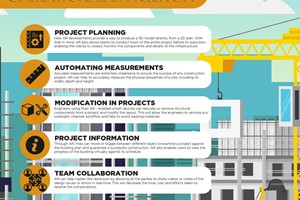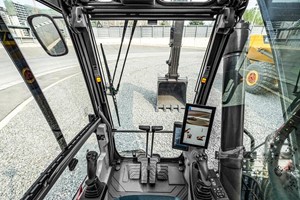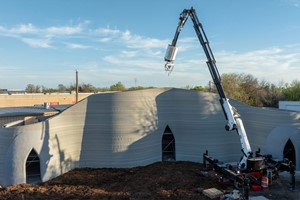The construction sector in the United States builds structures worth around $1.3 trillion every year and employs over 7 million laborers. But due to its complex and fragmented nature, the industry faces several challenges in communication, design and project management.
There can be some complications in the design of the structure, which are detected after the construction has already begun. Such complications increase the cost and delay the entire project. The safety of the workers on the site of construction is also a significant concern. There are chances that some anomaly or design errors can lead to accidents and maybe even the death of the workers. Augmented Reality (AR) can help to evade such challenges.
AR combines the user’s physical surroundings with computer-generated information in real-time using advanced sensor technology and cameras. By merging physical and digital views, AR in construction can help the project teams and employees to drive efficiency and boost confidence in their projects.
How Can AR in Construction Improve Operational Efficiency?
Augmented Reality presents real-time data using cameras and GPS geo-spatially. It displays and updates essential information as the user travels throughout the infrastructure space. Due to the ability of AR to provide real-time information, the construction industry will be able to improve safety, streamline operations and collaboration, increase productivity and boost project confidence.
- Project Planning
New AR developments provide a way to produce a 3D model directly from a 2D plan. BIM (Building Information Modeling) software helps all the different teams of engineers and architects of a project to effectively collaborate with each other. Combining 3D modeling software with BIM, construction organizations can generate interactive, detailed models of building or infrastructure projects and present the same to clients before the start of a project.
An example is Gamma AR. It overlays 3D BIM on the job site and mitigates errors, reducing time spent on documentation and rework. It enables the user to compare the project planning with reality to help find any differences.
AR also allows teams to conduct tours of the entire project before its execution, enabling the clients to closely monitor the components and details of the infrastructure. Implementing client involvement at the beginning of the process at this level helps prevent any costly changes later and keeps clients engaged with every part of the project.
- Automating Measurements
Accurate measurements are extremely imperative to ensure the success of any construction project. AR can help to accurately measure the physical properties of a site, including its width, depth and height. To get a holistic view of how the project will look, construction organizations
can integrate this measurement data, which will help them create a more accurate structure. AR will also allow field workers to automate measurements on the job site. Workers will be able to automatically make measurements of the components and compare them against the specified measurement in the infrastructure model. This will enable the workers to find any defects or inconsistencies and quickly adjust them to prevent any delays or incurring extra costs.
An example of this is Spike software that enables a user to measure any object by simply snapping a picture with a smart device (mobile or tablet). It helps to capture real-time measurements, including width, height, depth and area surface.
- Modification in Projects
One significant ability of AR is that it allows users to make changes to the building or infrastructure models directly on the construction site. With the help of a mobile device or headset, workers can easily see exterior and interior views of a structure and make any changes to the virtual plan while preserving the original view. For example, engineers using their AR-enabled smart devices can relocate or remove structural components from a project and modify the layout. This will allow the engineers to remove any oversight, improve workflow and help to avoid wasting materials.
- Project Information
Workers will be able to view information about the location of the outlet, walls, pipes, ventilation and switches. Through AR, they can move or toggle between different layers to examine a project against the building plan and guarantee a successful construction. For instance, a contractor can use a mobile device, tablet or headset to identify the location of each drill hole mentioned in the structure plan and ensure its proper placement. AR also enables users to view the progress of the building virtually against its schedule.
- Team Collaboration
Building infrastructure requires collaboration between many teams, including designers, electricians, welders, carpenters and project managers. Collaboration among the teams is termed successful when the project is completed on schedule and according to the allocated budget. But not everyone is present on construction sites at the same time, which can cause communication issues. Any complication that occurs can only be resolved when all the parties involved assemble and review the blueprints. In this regard, AR can help hasten the resolution by allowing all the parties to share videos or notes of the design issues or errors in real-time. This will decrease the time, cost and efforts taken to resolve the complications.
- Safety of Workers
The safety of workers on construction sites is a massive concern. In the United States, construction workers that suffer non-fatal injuries are over 200,000 and fatal injuries are over 1000. The rate of injury in the field of construction is 71% higher than injury rates across any other industry. Safety programs require a lot of time and money and are not correctly communicated to the field workers. Therefore, by using an AR-enabled device, workers can access instruction and safety scenarios as well as undergo virtual drills. This type of direct learning will not only improve the awareness of workers' safety and intuition development but also reduce training time and costs. AR devices can also create an alert to notify the workers by prompting them to move out of the way quickly or find a safer route out of a dangerous situation. AR solutions will flag the threats, offer alternatives and keep the workers secure and safe.
AR solutions offer tools to construction organizations to plan a project from the beginning to the end while ensuring accuracy, preventing rework and reducing costs. AR can boost overall operational efficiency and precision, leading to improved client relations and satisfaction. From offering insight to eliminating complications, AR in the field of construction can streamline the entire lifecycle of a project. As AR technology advances, AR in construction will become an indispensable tool that has the potential to revolutionize the future of construction.
Naveen Joshi











